If you spend a lot of time browsing the plant side of Instagram and Pinterest, you’re likely to come across the Philodendron ‘Pink Princess’—or PPP, as plant aficionados like to call it.
It’s pretty recognizable, thanks to the fact that it’s, well, bubblegum pink. The variegated pink leaves have made this plant a popular specimen for many new gardeners, and a wider pool of propagation means it’s now easier to find (and at a more reasonable price—up until recently, a cutting would fetch upwards of $100).
If you’ve got your hands on one, this guide will tell you everything you need to know to care for Philodendron ‘Pink Princess’ and keep the plant healthy, happy, and yes—pink!
| Common name(s) | Pink Princess, Pink Princess Philodendron, blushing Philodendron, PPP |
| Scientific name | Philodendron erubescens ‘Pink Princess’ |
| Family | Araceae |
| Height and spread | Up to 4 feet tall and 18 inches wide |
| Light | Bright indirect |
| Soil type | Rich but well-draining; aroid soil mix |
| Water | Keep lightly moist |
Disclosure: If you shop from my article or make a purchase through one of my links, I may receive commissions on some of the products I recommend.
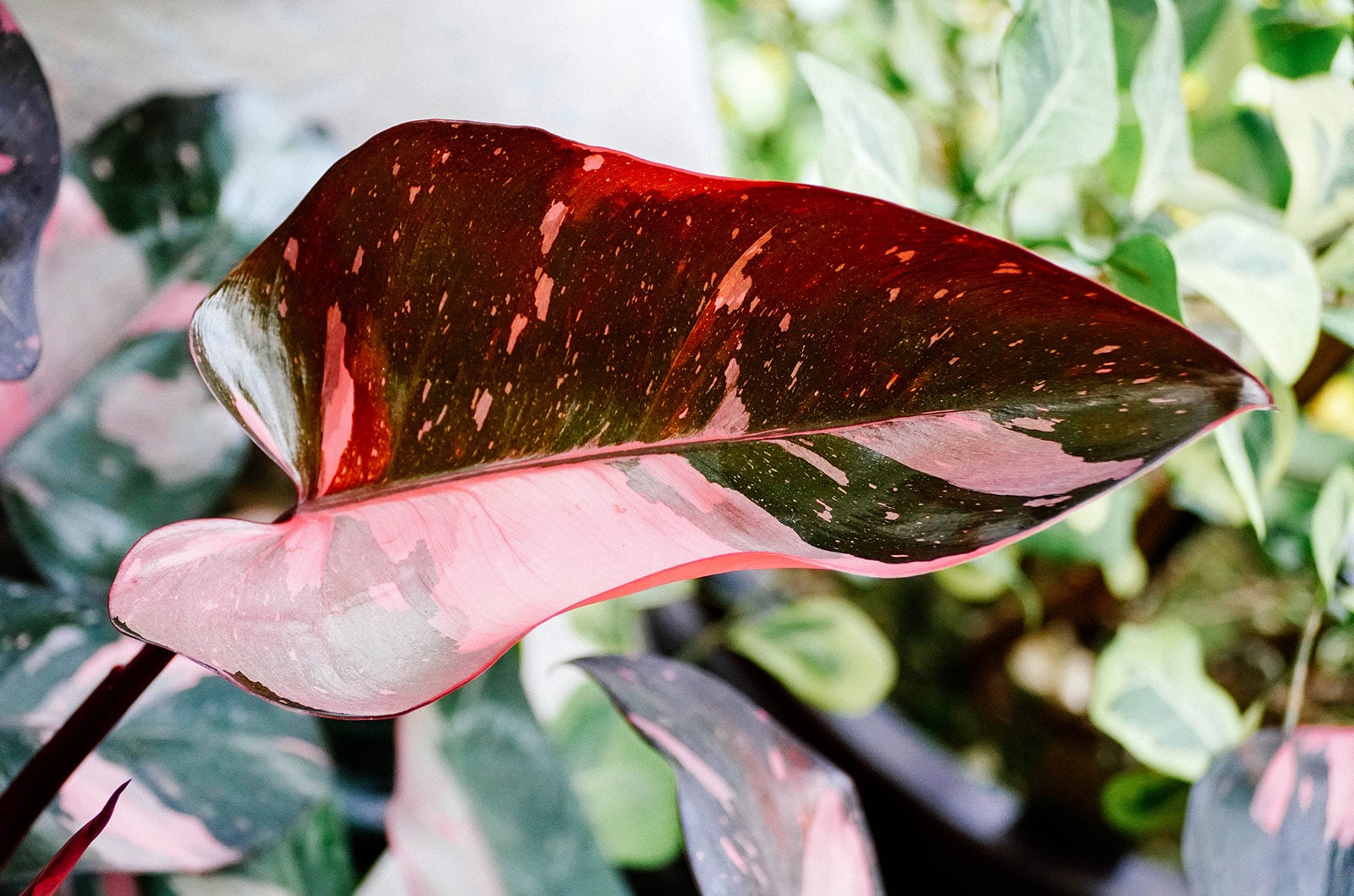
About the Pink Princess Philodendron
Origin
While Philodendron erubescens is native to Central and South America, the true origin of Philodendron ‘Pink Princess’ remains a mystery.
One theory is that Pink Princess is just a spontaneous mutation of Philodendron erubescens.
Others speculate that Pink Princess was part of R.H. McColley’s extensive breeding program at Bamboo Nursery in Apopka, Florida, which specialized in hybridizing Philodendrons in the 1960s and 1970s.
Related: My Favorite Philodendron Varieties That You’ll Love Too
However, McColley and his partner were meticulous in documenting their hybrids and patented every cultivar from their breeding program before introducing it to the world. McColley would’ve claimed Pink Princess as one of his own, but no mention of the hybrid has been found in any of his scientific papers.
The late Steve Lucas, a botanist who served on the International Aroid Society Board of Governors, also tried to trace the lineage of the unique plant. He learned that a grower in Florida claimed to have hybridized Philodendron ‘Pink Princess’ from at least seven parent plants (Philodendron species that were cross bred to develop ‘Pink Princess’).
However, many of the purported Philodendrons in the grower’s hybridization had no genetic capability of cross breeding with each other. In other words, the Philodendron crosses in ‘Pink Princess’ were botanically impossible.
So, the conclusion is that whoever discovered the Pink Princess Philodendron claimed some bogus lineage, or the hybrid occurred through a spontaneous but natural mutation.
Once the plant became known, the rights to the Pink Princess Philodendron were sold to a tissue culture company and it was mass produced.
Did you know? Due to social media’s love affair with pink plants, another pink Philodendron has appeared on the scene: Pink Congo. It looks very similar to Pink Princess, but has slightly pointier leaves that are completely pink, as if dipped in paint.
Unfortunately, the pigment is entirely fabricated by growers. It was discovered the plants are chemically gassed in greenhouses to produce plant hormones that temporarily change the color of the leaves. Over time, the pink leaves revert to green.
Description
The most immediately charming thing about the Pink Princess Philodendron is the name. It’s even delightful in Latin: Philodendron erubescens means “blushing” Philodendron.
Once you get a look at it, you can see where the moniker comes from. This isn’t your typical Philodendron (like Philodendron gloriosum, another popular species) that’s green from leaf to stem.
On the Pink Princess, scattered among its glossy, heart-shaped, dark green to black leaves, are splashes of bright pink.
This pink color is what’s made the Pink Princess such an in-demand plant over recent years. The pigmentation is known as variegation, and it refers to when areas of the leaf lack chlorophyll.
It’s rare to find a plant in nature with black leaves, and that’s what makes Pink Princess so unique: It’s a black or nearly black Philodendron with hot pink variegation.
Related: Stromanthe Triostar: Easy Care Tips for This Striking Pink-Streaked Houseplant
The Pink Princess Philodendron is an evergreen vining plant from the Araceae family (the aroids) that can grow up to 4 feet tall, but usually stays around 2 feet when kept as a potted plant.
It has burgundy stems and petioles and aerial roots that emerge from nodes. New leaves unfurl with burgundy coloration (gradually becoming variegated) or with pink and white variegation in place.
Why is the Pink Princess Philodendron so expensive?
Short answer: because it’s rare.
Although Pink Princess is a cultivar of Philodendron erubescens, which is relatively common, pink variegation in Philodendrons doesn’t happen all too often on its own. To produce the mottled bubblegum-pink pattern, the plant must be grown from tissue culture, a slow and unpredictable process that few growers are willing to risk time and money in.
Not every batch will produce pink coloring, even if the mother plant is heavily speckled with pink. And every new leaf that emerges may turn out solid-colored, lightly variegated, or heavily variegated, which adds to the excitement.
Like a true princess, PPP keeps you guessing as to what she’ll do next!
This unstable variegation, coupled with increasing demand from social media, means prices for this pink beauty remained high for a long while, though that’s starting to change now. If you’re patient and persistent, you can often find a Pink Princess cutting or plant for much less than it retailed for a year or two ago.

Pink Princess Philodendron varieties
The dazzling variegation of Pink Princess has created huge demand for the houseplant and inspired growers to breed new cultivars, creating interesting new patterns and colors.
It’s important to note that the Pink Princess Philodendron has natural variations in its pink and white patterns. Sometimes these specimens are given false cultivar names and sold at a premium for being “rare” cultivars, so always be aware of what you’re buying.
- Pink Princess (Common Variegation or ‘Sparkle’): The most common form of Pink Princess Philodendron has large chunks of pink alongside its green leaves. Sometimes the plant pushes out “half moons” where half the leaf is completely pink and half is completely green! While the look is spectacular, this can be risky for the plant if it reverts to all green leaves (losing its signature variegation) or pushes out all pink leaves (which lack chlorophyll). I’ve seen some sites market this type of Pink Princess as ‘Sparkle,’ but this an unregistered cultivar name.
- Pink Princess (Marble Variegation): Another type of variegation that occurs in Pink Princess is marbling, which is common in variegated plants (like Marble Queen Pothos, Monstera Thai Constellation, and Monstera Albo). With marbled variegation, the leaves have a speckled appearance with random splashes of pink and white.
- Pink Princess ‘Black Cherry’: This is an unregistered cultivar with vibrant red variegation on black leaves. The leaves also appear to be thicker than those on the original Pink Princess. Owners of ‘Black Cherry’ claim that the red and black coloring remains constant even as the plant matures, though if you try to buy one, be warned that there’s no guarantee this type of variegation can be maintained in the long term.
- Philodendron ‘Pink Anderson’ or ‘White Anderson’: This unregistered new cultivar is native to Indonesia and I couldn’t find very many details on it, but it’s supposed to be a cross of Philodendron ‘Pink Princess’ and Philodendron ‘White Knight.’ Its burgundy petioles, leaf shape, and color patterns are similar to Pink Princess, and the variegation in the leaves emerge pink but turn white as they mature.
Where to buy Philodendron ‘Pink Princess’:
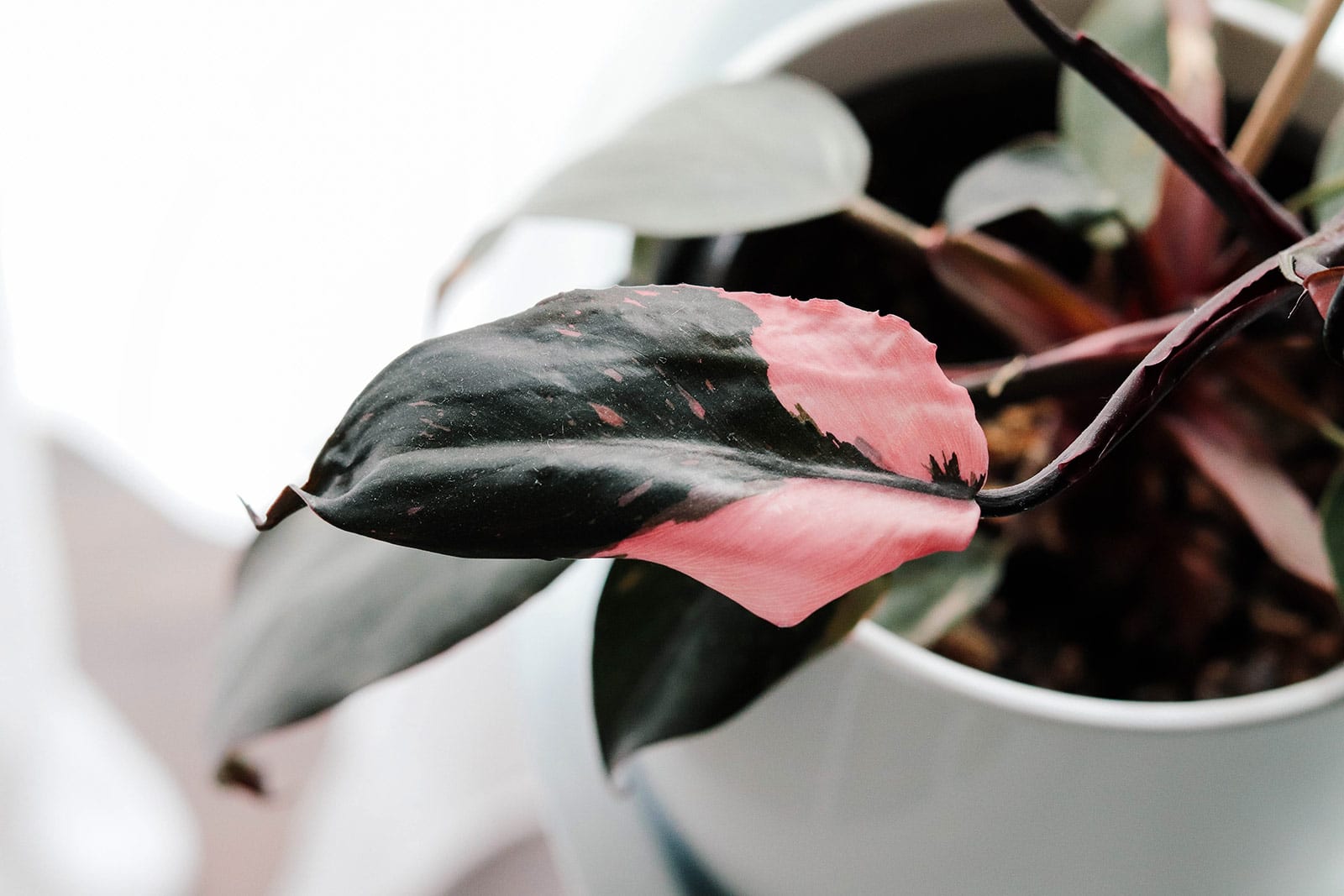
Caring for the Pink Princess Philodendron
Light and temperature
To understand what kind of light and temperature the Pink Princess Philodendron prefers, think of where its mother plant (Philodendron erubuscens) naturally grows: in the lush, tropical rainforests of Central and South America, where the climbing plant is part of the understory.
That means it requires bright, indirect light, which mimics the dappled sun it would experience under the rainforest canopy. At home, the best place for the Pink Princess Philodendron is in front of an east- or west-facing window. This will allow it to see bright sunlight for several hours a day and spend the rest of the time in shade.
With its unique coloring, this plant won’t be afraid to tell you whether it’s getting enough (or too much) light.
If there’s too much sun, the blackish leaves will turn green and the pink variegation will turn white. Extended periods in direct sun can also scorch the leaves.
If there’s too little sun, your Pink Princess Philodendron can lose its variegation by pushing out new green leaves, which are able to capture more light.
Temperature-wise, the plant is happiest between 60°F and 85°F. It can survive temperatures as low as 55℉, but this shouldn’t be sustained as it can cause your plant to stop growing altogether.
Despite its love of warmth, the Pink Princess Philodendron doesn’t like extreme temperatures on either end. Avoid placing the plant next to an A/C unit or near a fireplace, heating vent, or other heating element.
A good rule of thumb is if you feel comfortable, then your plant will too.
Water and humidity
While the Pink Princess Philodendron is fairly adaptable, there’s one thing it can’t stand: being improperly watered.
Many people err on the side of overwatering since they assume tropical plants like more moisture, but as a climbing plant, your Pink Princess Philodendron can actually tolerate short periods of dryness.
Let your plant partially dry out before giving it a good, deep watering. To check the soil, simply use the finger test: If the top 2 inches feels dry, it’s time to water. Pour water over the plant generously until it flows freely out the drainage hole.
Never let the plant sit in standing water, as this can lead to root rot, killing your beautiful (and expensive) Pink Princess.
How often you have to water will depend on the light, temperature, and humidity in your home. In summer, keep the soil slightly damp. In winter, reduce watering so the soil doesn’t get waterlogged.
Humidity is where many owners of the Pink Princess Philodendron start to struggle. This is an aroid from a tropical environment and it needs a great deal of humidity, much like other beloved houseplants from the Araceae family (like Philodendron ‘Birkin’, Anthurium andraeanum, Syngonium podophyllum, and Alocasia x amazonica ‘Polly’).
In the home, humidity levels should be above 50 percent. Not sure where yours are at? This is the digital hygrometer I use and recommend.
Most people don’t live in this moist of a climate (especially in winter when the heat is on), but there are some relatively simple fixes to increase the humidity in your home:
- Use a humidifier. There are many humidifiers on the market, and they can be highly beneficial for your plants (and your skin!). A humidifier can raise relative humidity levels by 50 to 60 percent, creating the perfect environment for your Pink Princess Philodendron.
- Group your plants together. By displaying your plants in large groupings, you end up creating a more humid microclimate. This happens via transpiration, a process whereby plants release moisture through their leaves.
- Mist your plant. Some gardeners swear by misting, while others find it doesn’t make much difference. To give it a go, simply use a spray bottle to mist the leaves with a fine layer of water once a day.
- Place your Pink Princess in the bathroom. The bathroom is a naturally humid environment and a surprisingly good place for a Philodendron to thrive. If your bathroom has filtered sunlight streaming through a window or skylight, this could be the perfect spot.
Soil and planting
Most aroids prefer loose, fast-draining, nutrient-rich soil mixes.
You can buy a specialty soil mix like this one that’s formulated for Philodendrons, though personally, I’d add a handful of perlite to make sure the mix is well aerated.
If you like things a little more hands-on, however, you can easily create your own aroid mix. You need a good balance of moisture retention and aeration, and I use this simple formula for remembering how to make it: 4-3-2-1.
That means 4 parts orchid bark, 3 parts houseplant potting soil, 2 parts coco coir, and 1 part perlite. (A part is any unit of measurement, such as a handful, a scoop, a bucket, or a gallon.)
Just mix these ingredients together for a well-rounded Philodendron potting soil that you can use for other aroids, too.
Recommended products for Philodendron ‘Pink Princess’ plant care:
- Soil Sunrise Philodendron Houseplant Potting Soil
- Good Earth Organics Premium Potting Soil
- Better-Gro Orchid Bark
- Burpee Organic Coconut Coir
- Perfect Plants Organic Perlite
- ThermoPro Digital Hygrometer
Fertilizing
Despite its name, Pink Princess isn’t too fussy about fertilizer. It typically doesn’t need any plant food but can benefit from an occasional feed during its growing season.
Use a balanced liquid fertilizer in a diluted concentration (half-dose is what I aim for) once a month, and never fertilize when your plant looks stressed.
Before you fertilize, make sure to water the plant well so the plant food travels all through the soil mix and doesn’t sit in one place.
Only fertilize between March and October when your Pink Princess Philodendron is actively growing. The plant halts growth over winter, so it won’t benefit from a feed.
Recommended fertilizers for Philodendron ‘Pink Princess’:
- Houseplant Resource Center Liquid Fertilizer for Houseplants
- Instant Biologics Instant Plant Food (Fizzing Nutrient Tablets)
- Maxsea All-Purpose Seaweed Plant Food
Pruning
Although the Pink Princess Philodendron has vining tendencies, it can easily be made more bushy with proper pruning.
You can encourage new growth points by cutting the stem in between nodes. (A node is a small bump where each leaf meets the stem or vine.) The best time to prune is in spring, right before it starts to grow again.
You can also prune your Pink Princess Philodendron to maintain balanced variegation.
For example, if the top leaves on your plant are all green or all pink but you prefer a more speckled pattern, find the most evenly variegated leaf and cut right above its node. Pruning above your chosen leaf encourages the new leaf to mimic the pigment pattern of the leaf below it.
Dividing or repotting
When young, the Pink Princess Philodendron can grow rapidly (averaging one new leaf every month) and needs to be repotted once a year. As the plant ages, repotting every two to three years is fine.
When choosing an initial pot, make sure you leave some room for the roots to grow. Measure the root ball, then find a pot that’s 2 inches larger in both width and height.
Choose a pot with good drainage holes, or do what I like to do: pot up the plant in a plastic container with drainage holes, then place it in a larger decorative pot.
Water the plant thoroughly before repotting to reduce stress. Every time you repot, the next pot should be a size up (or roughly 2 inches larger all round).
If your plant is getting too unwieldy or you don’t want such a large plant, you can divide it and repot individual sections (which I’ll cover below in the section on propagation).
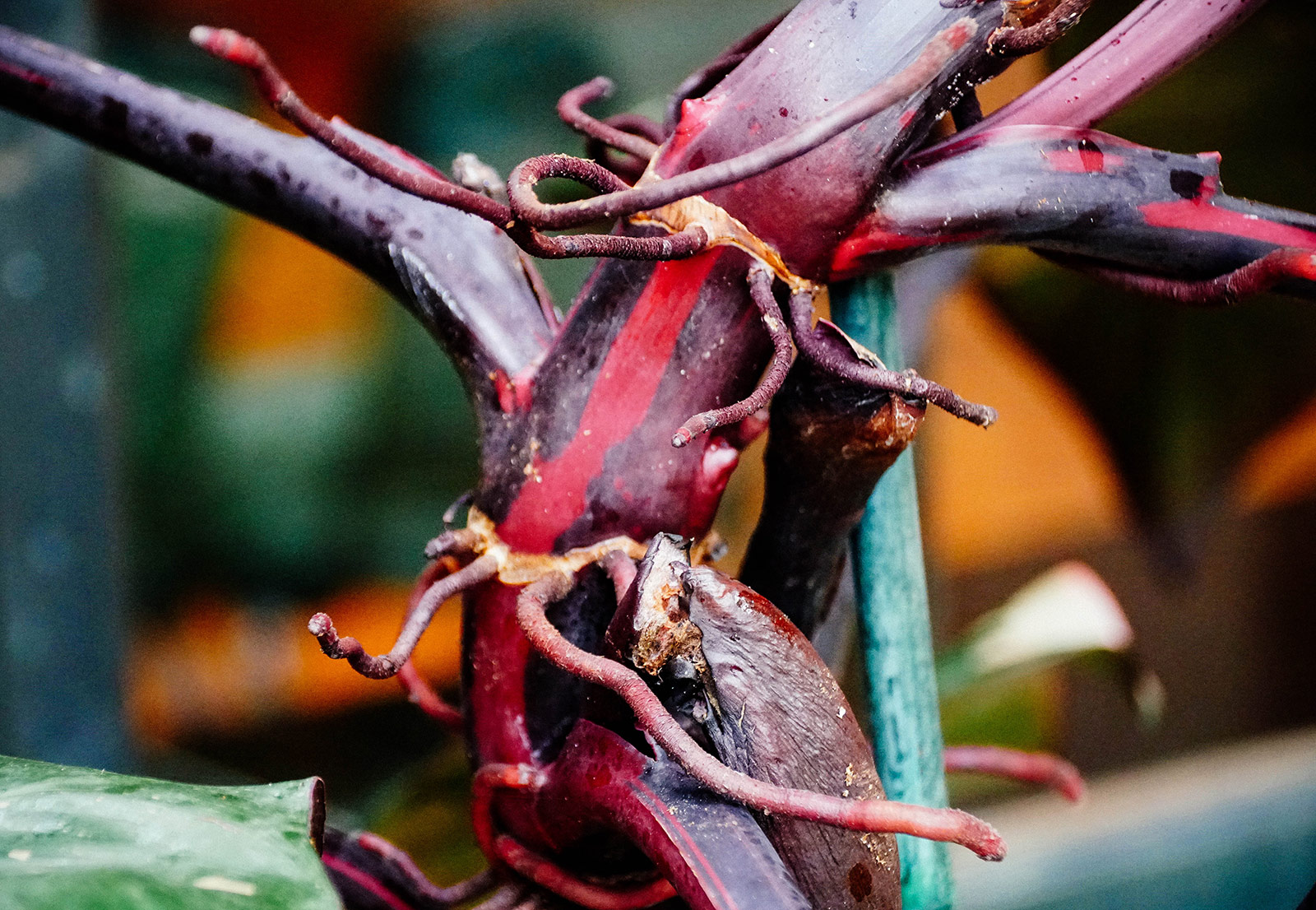
Propagating the Pink Princess Philodendron
With the Pink Princess Philodendron being so coveted, you’re likely to have friends clamoring for a piece of it. Luckily, the plant is very easy to propagate through cuttings or division (though the amount and type of variegation is never guaranteed).
Cutting method for propagating Pink Princess Philodendron
- Look over your plant to find the best areas of growth, with plenty of variegation. Cut a stem away about 1/4 inch below the node. Take multiple cuttings for a better chance of successful propagation. Each cutting should have a couple of healthy leaves showing pink coloring.
- Place each stem into water. The node of the stem needs to be immersed in water, with the leaves hanging free. Place the cuttings in a warm area with plenty of sunlight.
- After a month has passed, you should begin to see the root systems forming. They should be self-supporting at roughly five weeks old.
- When the roots have about 2 inches of growth, they can be potted using an aroid soil mix. After three weeks, the roots should be well-established in the soil mixture.
Division method for propagating Philodendron Pink Princess
- Begin by watering your Pink Princess Philodendron well. Gently lift the root ball out of the pot and carefully comb away the soil. This should expose the root system.
- Look through the roots to find baby plants with a developed stem and root system. There should be roughly four stems to the root. These can be separated and repotted on their own.
Pink Princess Philodendron seeds
If you’re struggling with propagation, you might be tempted by growers selling Pink Princess Philodendron seeds. Don’t buy them!
The seeds might grow into new plants, but they won’t grow into a Pink Princess. Instead, they’ll just be leafy green—and definitely not worth the money.
The variegation in a Pink Princess Philodendron is an unstable mutation that occurs randomly. A reliably variegated plant can only be propagated by cuttings from a mother plant.
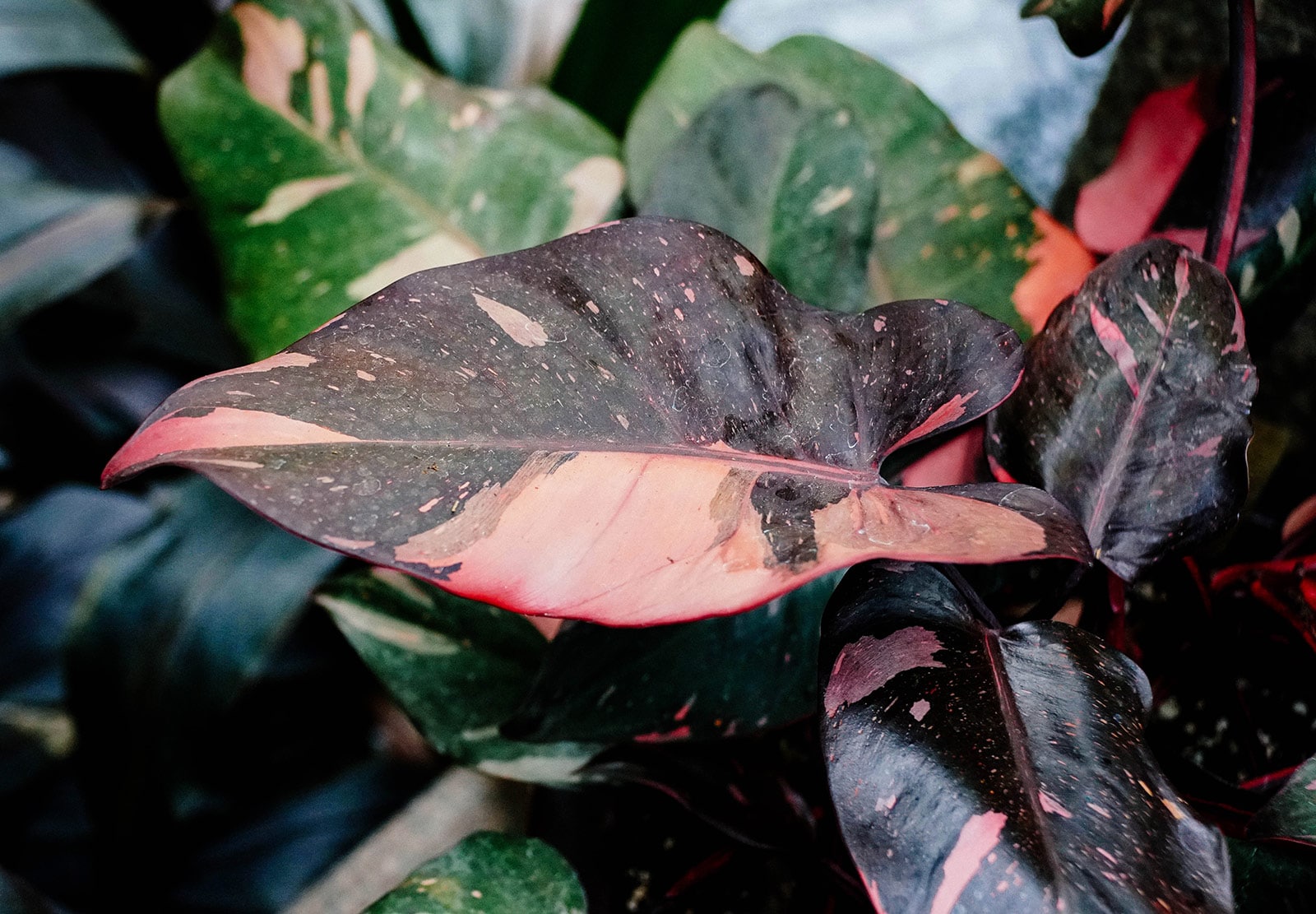
Pests and diseases
Your Pink Princess Philodendron isn’t affected by many pests or diseases. Keep an eye out for aphids or mealybugs, which might attack the leaves. These pests can be controlled organically with a homemade insecticidal soap, or simply by cutting off affected leaves.
One thing you do need to look out for is sad, wilting leaves. These often occur when conditions aren’t quite right. If spotted in time, you should be able to keep your Pink Princess healthy by adjusting your watering (the reason is usually overwatering), adjusting the amount of sunlight, or increasing humidity levels.

Common questions about the Pink Princess Philodendron
How do I get pink leaves on the Pink Princess Philodendron?
If you’ve paid a pretty penny for a Philodendron Pink Princess, then you want to see those fabulous pink leaves! To achieve this, you need to get the light levels just right.
The Pink Princess needs bright indirect light for around 6 hours every day. This mimics the dappled light of its natural rainforest habitat.
As lovely as the pink is, however, not all the leaves should be this color. Instead, you should aim for an even variegation—green and pink, mixed together. Pink leaves lack chlorophyll, so they can’t absorb light and nutrients as well as green leaves.
A Philodendron with all pink leaves is unhealthy and will die eventually. If too much pink starts taking over, prune back the leaves to encourage variegation.
Is the Pink Congo the same as the Pink Princess Philodendron?
No, the Pink Congo Philodendron is not the same as the Pink Princess Philodendron. And it’s not worth buying, as unscrupulous sellers may ask hundreds of dollars for what’s actually an ordinary Philodendron.
It’s believed the Pink Congo houseplant is chemically gassed in greenhouses to produce a plant hormone that temporarily changes the color of the leaves. The lower leaves are typically all green, but the top leaves are all pink. As they grow, however, they’ll revert to green.
Some sellers try to pass off a Pink Congo as a Pink Princess, so be alert. You can tell them apart by the Pink Congo’s lack of variegation.
The Pink Princess has leaves that are a mixture of pink and green. On the Pink Congo, leaves are fully pink.
Is the Pink Princess Philodendron toxic to cats and dogs?
Unfortunately, all Philodendrons (including Pink Princess) are toxic to pets. The plant sap contains calcium oxalate crystals that may be irritating to skin on contact.
If the plant is ingested, it could cause stomach pain, diarrhea, swelling of the tongue, and in extreme situations, difficulty swallowing or breathing.
View the Web Story on Pink Princess Philodendron plant care.


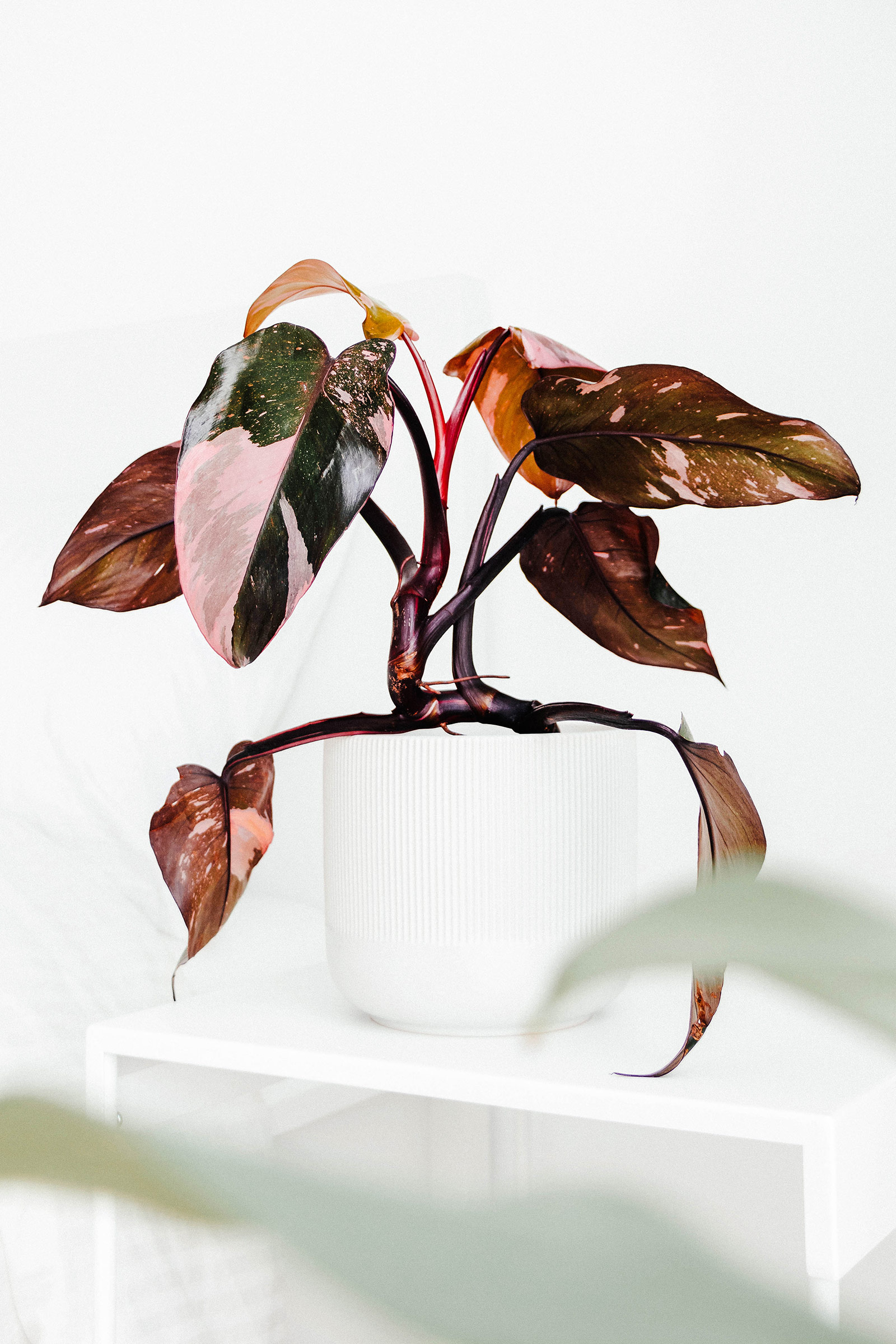













Should the PPP have a moss pole to grow on since it likes to climb?
Good, extensive advice on the Pink Princess Philodendron. Thank you!
You’re welcome Susan!
Great work Linda. Covered all the queries I had in mind.
good and complete article, thanks for the information, I like it.
beautiful plant, thanks for the article.